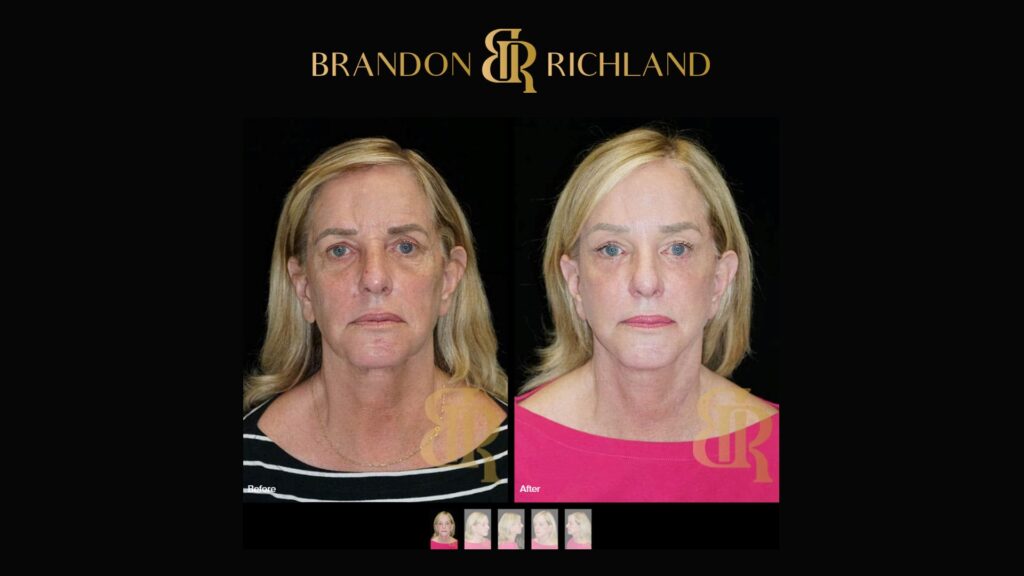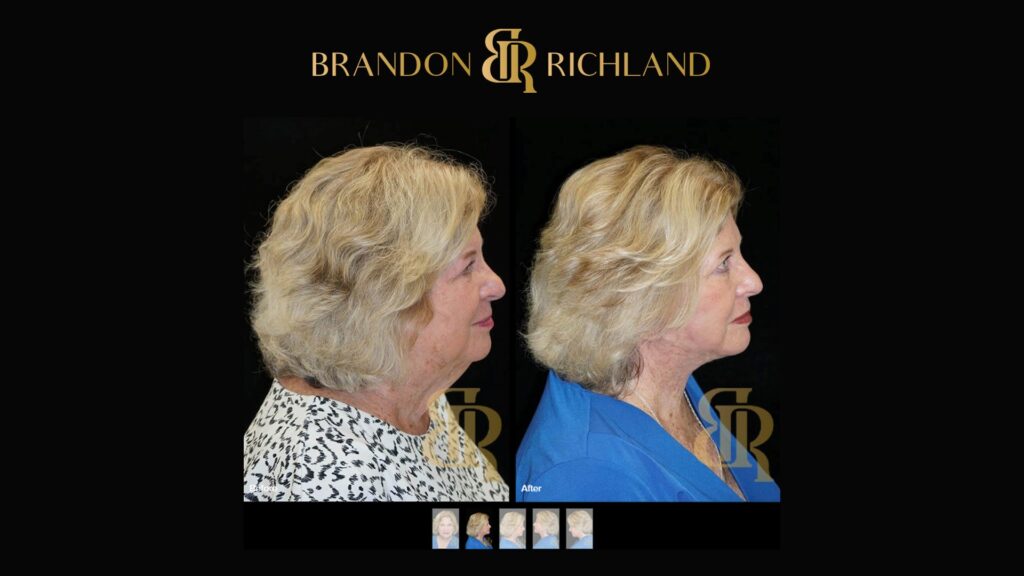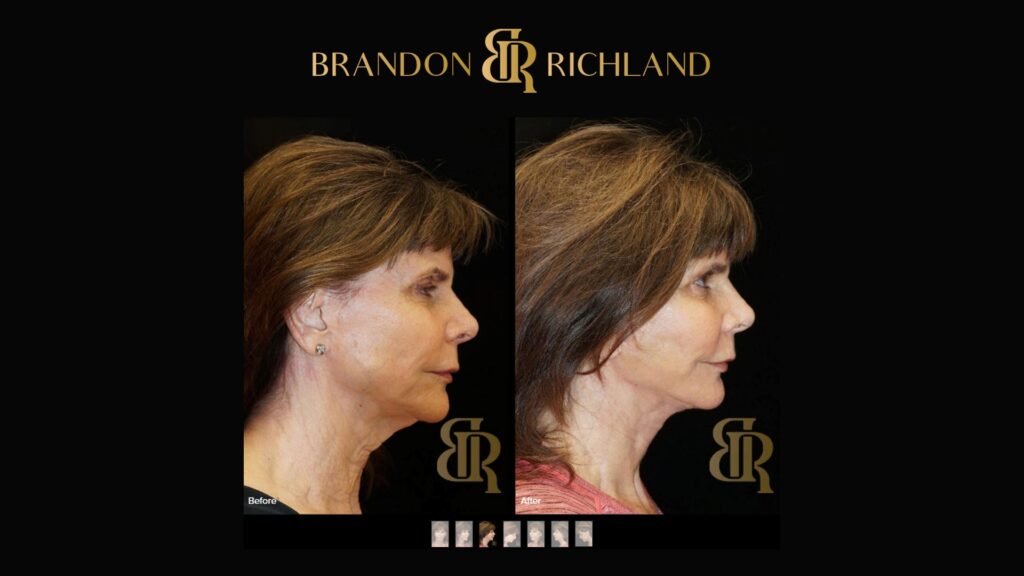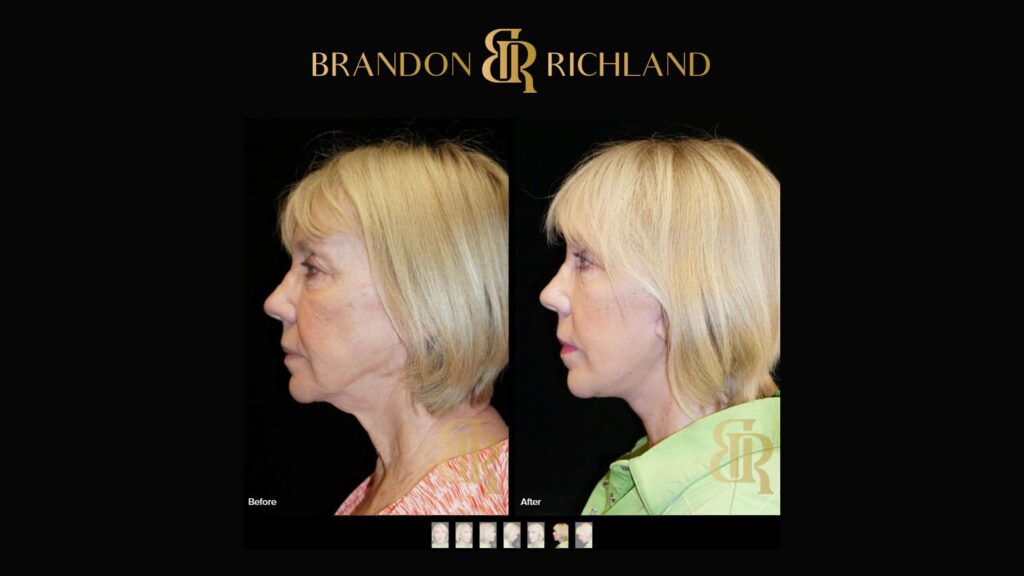Published by Dr. Brandon Richland, MD

Considering a facelift or rhytidectomy is a cosmetic surgery aimed at reducing signs of aging by lifting and tightening the skin and underlying tissues. Can be a significant decision for anyone looking to rejuvenate their appearance. Before diving into the procedure, one might wonder what kind of results they can expect.
Facelift before and after photos provide valuable insights into the potential outcomes, helping individuals understand the transformation they might experience. These photos showcase the procedure’s effectiveness in tightening and smoothing the skin, restoring a youthful look.
Key Takeaways of Facelift Before and After
- Facelift before and after photos are crucial for setting realistic expectations.
- Viewing photos from different techniques helps in understanding potential results.
- Comprehensive information aids in a well-informed decision-making process.
Complementary Procedures of a Facelift
Combining a facelift with other procedures can significantly enhance results. These additional techniques can target different areas of the face and further improve overall appearance.

Brow and Neck Lifts
A brow lift targets the upper third of the face. It raises sagging eyebrows and smooths forehead wrinkles, creating a fresher look. Combining a brow lift with a facelift helps achieve a balanced, youthful appearance. Techniques like the endoscopic brow lift involve small incisions and a camera to guide the surgery, causing less scarring.
A neck lift complements a facelift by tightening loose skin and removing excess fat under the chin. This procedure sharpens the jawline and smooths the neck, addressing areas a facelift might miss. The combination offers a cohesive enhancement, improving overall facial symmetry.
Eyelid Surgery and Fat Transfer
Eyelid surgery, or blepharoplasty, focuses on the eye area. It corrects drooping upper lids and puffy bags under the eyes. This surgery can make the eyes look more open and less tired. Combining upper blepharoplasty with a facelift targets multiple aging signs at once, leading to a refreshed and youthful face.
Fat transfer uses a patient’s own fat to add volume where it’s needed, such as the cheeks or lips. This method can complement a facelift by restoring lost volume and enhancing facial contours. The fat is usually taken from areas like the thighs or abdomen and then purified and injected into the desired spots.
Laser Resurfacing and Fillers
Laser resurfacing improves skin texture and tone by removing damaged outer layers of skin and stimulating collagen production. This enhances the skin’s appearance, reducing wrinkles, scars, and blemishes. When paired with a facelift, laser resurfacing addresses tonal and textural issues that a facelift alone cannot.
Fillers are injectable substances that add volume and smooth deeper facial lines. They can be used to enhance the results of a facelift by targeting specific areas like nasolabial folds or marionette lines. Fillers can also maintain results over time, keeping the face looking youthful and vibrant for longer.
Facelift Recovery and Aftercare
Facelift recovery involves managing initial post-surgery care and ensuring long-term healing and scar management. Patients need to be mindful of incision care, dealing with swelling, and following their surgeon’s specific advice.

Immediate Post-Operative Care
After a facelift, the first few days are crucial for reducing swelling and promoting healing. Patients typically need to keep their head elevated while sleeping to minimize swelling and tension on incision sites. They might have surgical drains to remove excess fluid and prevent blood from accumulating under the skin, which helps reduce post-surgery bruising and swelling.
Avoiding physical activity is important during this time. Patients should refrain from heavy lifting, bending, or any strenuous activities. It’s also essential not to apply makeup during the first week and avoid using nicotine products, as these can affect healing. This period also involves regular check-ins with the plastic surgeon to monitor progress and manage any issues with scars.
Long-Term Recovery and Scarring
During the weeks following a facelift, continuous care is necessary to aid healing and reduce scars. Patients might still have some swelling and tightness three to four weeks post-surgery. Sutures are typically removed within this period, depending on the individual’s healing process and the specific procedure performed.
To manage scarring, patients should avoid exposing their incisions to the sun and use recommended scar treatment creams. Hair treatments such as coloring or bleaching should be avoided for at least four weeks to prevent irritation around the incision sites. Physical activity can be progressively increased after two weeks, but heavy lifting should still be avoided until the surgeon advises otherwise.
Evaluating Facelift Results
Evaluating facelift results requires careful examination of the before-and-after photos. Key points include looking at the consistency of the photos and assessing the details of the changes in facial features.

Before and After Photos Analysis
When evaluating facelift before and after photos, it’s important to check for consistent lighting, facial expressions, and camera distance. Consistent conditions ensure an accurate comparison.
Look at the individual’s jawline and neck area. A successful facelift should provide a more youthful and refreshed look by reducing sagging skin and enhancing contours. Examine the skin’s texture and tone for improvements.
Choosing a Qualified Plastic Surgeon for Facelift
Choosing the right plastic surgeon for a facelift is crucial to achieving the desired results safely. It’s important to consider the surgeon’s credentials, experience, and how comfortable you feel during the consultation.
Board Certification and Experience
The most important factor in selecting a plastic surgeon is their board certification and experience. A board-certified plastic surgeon has undergone rigorous training and passed comprehensive exams to ensure high standards of care. Look for a surgeon certified by the American Society of Plastic Surgeons (ASPS), as they have met these rigorous standards.
Experience is also key. Find out how many facelift procedures the surgeon has performed and ask to see before-and-after photos of previous patients. This can give you a clear idea of what to expect and the surgeon’s style. A surgeon with a proven track record is more likely to deliver satisfying results.
Consultation and Trust
The consultation is a vital step in choosing a surgeon. During this appointment, the surgeon should answer all your questions and explain the procedure in detail. Pay attention to how comfortable you feel with them. They should make you feel at ease and provide clear, honest information about the surgery, recovery, and potential risks.
It’s also a good idea to bring a list of questions and concerns to the consultation. This ensures you cover all aspects and helps in determining if the surgeon is the right fit. Trust and good communication between you and your surgeon are essential for a positive experience and successful outcome.

Frequently Asked Questions About Facelift Before and After
1. What Is The Best Age to Have a Facelift?
The ideal age for a facelift often ranges from 40 to 60 years old. This is when signs of aging, such as sagging skin and deep wrinkles, typically become more noticeable. Results may vary based on individual health and skin condition.
2. How Long Will The Results of a Facelift Last?
Facelift results typically last between 7 to 10 years. Factors like genetics, lifestyle choices, and skin care can affect the longevity of the results. For some, touch-up procedures may be considered to maintain the desired look.
3. How Painful Is a Facelift?
Most patients experience mild to moderate pain after a facelift. Discomfort is common and can be managed with prescribed pain medications. Bruising and swelling are expected, usually subsiding within 10 to 14 days.

Conclusion and Summary of Facelift Before and After Surgery: Facial Transformations
Evaluating facelift before and after results highlights the transformative potential of plastic surgery in addressing facial aging and achieving facial rejuvenation. A facelift, often combined with procedures such as upper and lower blepharoplasty to remove excess skin, a lip lift to enhance lip contours, and laser skin resurfacing to improve skin texture, offers comprehensive solutions for those seeking a youthful appearance.
Both male and female patients benefit from these treatment options, with each facelift case tailored to the individual’s unique needs, age, and the expertise of their provider. For example, addressing sagging jowls and aged appearance through lower facelifts, liposuction, and fat grafting or fat injections can significantly enhance overall results.
Commonly paired procedures, such as an endoscopic browlift, lower eyelid surgery, and facial fat injections, contribute to achieving natural results. By addressing various aspects of facial aging, these combined treatments offer a holistic approach to facial rejuvenation. Patients should always keep in mind that their treatment plan should be personalized, and they should consult with their doctor to determine the best course of action for their specific needs and desired outcomes.
Please note that this article is intended for informational purposes only and should not be construed as medical advice. Before making any changes to your treatments, please consult with your healthcare provider to discuss the appropriateness and safety of such changes.
Ready For Your First-Class Cosmetic Experience in Orange County (OC) California (CA)?
Are you located in one of these Orange County (OC) / Southern California cities?
Aliso Viejo, Anaheim, Brea, Buena Park, Costa Mesa, Coto de Caza, Cypress, Dana Point, Fountain Valley, Fullerton, Garden Grove, Huntington Beach, Irvine, La Habra, La Palma, Laguna Beach, Laguna Hills, Laguna Niguel, Laguna Woods, Ladera Ranch, Lake Forest, Los Alamitos, Mission Viejo, Newport Beach, Orange, Placentia, Rancho Santa Margarita, San Clemente, San Juan Capistrano, Santa Ana, Seal Beach, Stanton, Tustin, Villa Park, Westminster, or Yorba Linda?
Plastic Surgeon Dr. Brandon Richland, MD and our Cosmetic Aesthetics Team are ready to help you look and feel your absolute best.
Elevate your confidence and self esteem levels to unfathomable new heights!
Schedule your in-person consultation in our modern and luxurious offices in either Fountain Valley, CA (Main HQ) or our Newport Beach, CA office.
Do you live outside of Southern California or short on time? For your convenience, Virtual Consultations are also available.
Our warm and engaging Team of carefully selected Aesthetics Professionals will make you feel calm, cool, collected, and right at home throughout your entire consultation and surgery process.
Schedule Your Aesthetics Consultation here, or call us directly at 949-867-4496 today.
About the Author

Dr. Brandon Richland, MD is a respected Board Certified Licensed Plastic Surgeon in Orange County / Southern California specializing in cosmetic and reconstructive surgeries.
Driven by his passion for medicine, Dr. Richland obtained his Doctor of Medicine (M.D.) degree from the prestigious program at Saint Louis University (SLU) School of Medicine in 2013. His exceptional skills were recognized when he received the McGraw Hill / Lange Medical Student Academic Achievement Award, and graduated top of his class with Honors. For his undergraduate degree, he attended University of California, Los Angeles (UCLA) and graduated with Honors in 2009.
To further enhance his surgical expertise, Dr. Richland completed his Residency in Plastic Surgery at the University of California, Irvine (UCI) from 2013 to 2019 earning the Academic Achievement Award twice during this period. A total of 14 years in dedicated schooling and medical residency.
Dr. Richland is actively involved with healthcare and medical societies, as a Diplomate of the American Board of Plastic Surgery, a member of the American Society of Plastic Surgeons, American Society of Aesthetic Plastic Surgeons, and the California Society of Plastic Surgeons.
Contact Dr. Richland today by visiting RichlandMD.com, scheduling a cosmetic consultation, or by calling 949-867-4496 directly.










